C2 Proficiency Essay Task (Writing Part 1) – COMPLETE GUIDE
This quite extensive piece offers an abundance of tips to help you gain a top mark for the compulsory C2 Proficiency essay task. The essay is part 1 of the writing test.
My plan for this post goes as follows:
- Explain the main focus and format of the essay task
- Share a sample C2 discursive essay task with a model answer
- Describe the detailed descriptors in the Cambridge English Writing Assessment subscales in relation to part 1 of the C2 Writing Test, i.e. the compulsory essay
- Assess a top-performing answer to a C2 Proficiency essay task
- Highlight the importance of writing a plan before writing your answer with an overview of the different parts of a discursive essay for C2
- Reveal the most important essay-writing skills you need to improve in the run up to your C2 exam
- Share some useful grammatical structures for discursive essay writing which you should acquaint yourself with before the exam
- Reveal some general tips for Preparing for the C2 compulsory essay
The Main Focus and Format of the C2 Proficiency essay task
First of all, the task focus of part 1 of the C2 writing test is discursive. Discursive writing, which is a style used in academic writing, requires one to examine and present the various perspectives offered by materials in an objective manner. In the case of the two texts in the C2 writing test, you are required to summarise and evaluate the key points in them in your own words - as far as possible, of course. Moreover, you must add your own ideas to those of the texts in your answer.
The ability to pick out key points from a text is considered paramount at C2 level. The CEFR (Common European Framework of Reference for Languages) states that, at C2 proficiency level, candidates should be able to ‘summarise information from different sources, reconstructing arguments and accounts in a coherent presentation of the overall result’.
Cambridge English asks candidates to write between 240-280 words for the essay. However, you won’t be penalised if you write slightly fewer than 240 or a little more than 280 words. To quote from the C2 Proficiency Teachers’ Handbook (printed in 2025): “Exceeding the recommended word range is … acceptable (though if there is resulting irrelevance, repetition or poor organisation, these may be penalised).”
The texts are roughly 100 words each. They are on the same topic and may present complementary or opposing views. The texts will be based on a variety of authentic, contemporary sources, including extracts from books, magazines, newspapers, online source material or even quotations made by speakers during a discussion.
A total of 20 marks are available for part 1 of the C2 writing test. Part 2 also carries 20 marks. The C2 Proficiency Writing paper lasts for 1 hour and 30 minutes in total.
Sample C2 Proficiency Essay Task with a Model Answer
In order to put the following sections of this post into their relevant context, allow me to share a sample C2 Proficiency writing part 1 essay task as well as a model answer with constructive comments from Cambridge English:
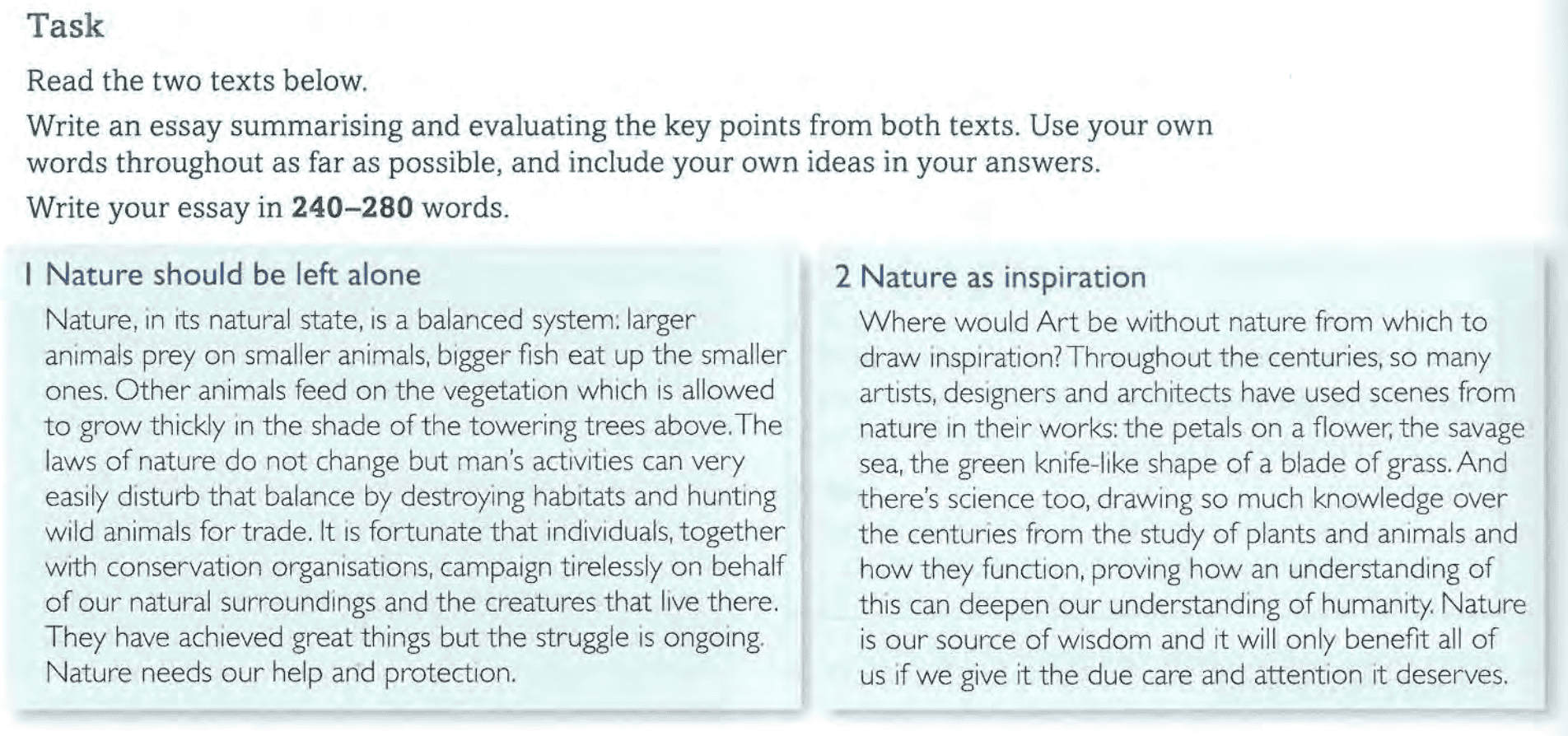
Source: Roderick, M. (et al.) (2013) Proficiency Expert Coursebook, Harlow: Pearson Education Limited, p.192
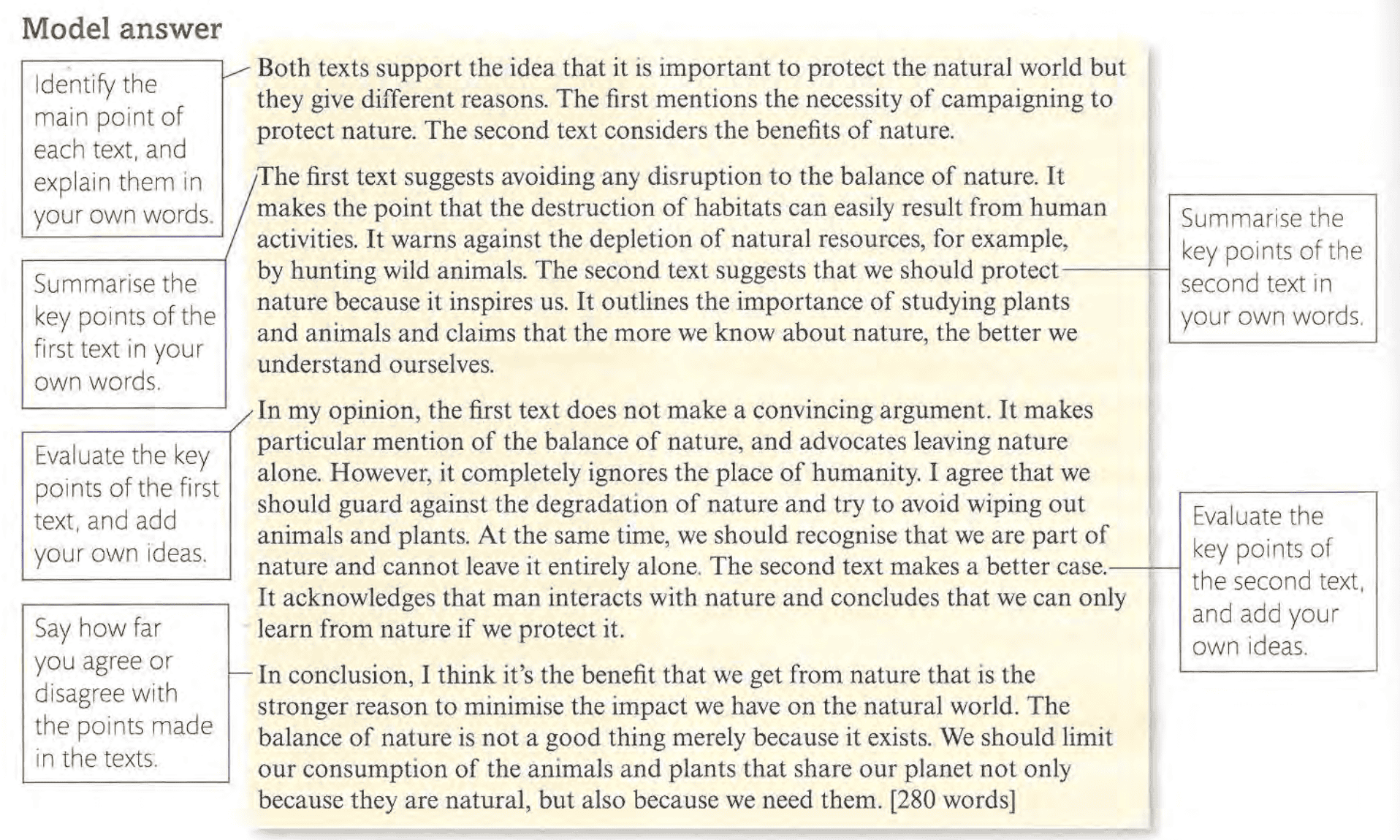
Source: Roderick, M. (et al.) (2013) Proficiency Expert Coursebook, Harlow: Pearson Education Limited, p.192
Writing Assessment Subscales for C2 Proficiency
As with other Cambridge English exams, both of the candidates’ compositions for C2 Proficiency are assessed in terms of four subscales: Content, Communicative Achievement, Organisation and Language.
With reference to those four subscales, Cambridge English examiners use the following points as a guide when marking a piece of work:
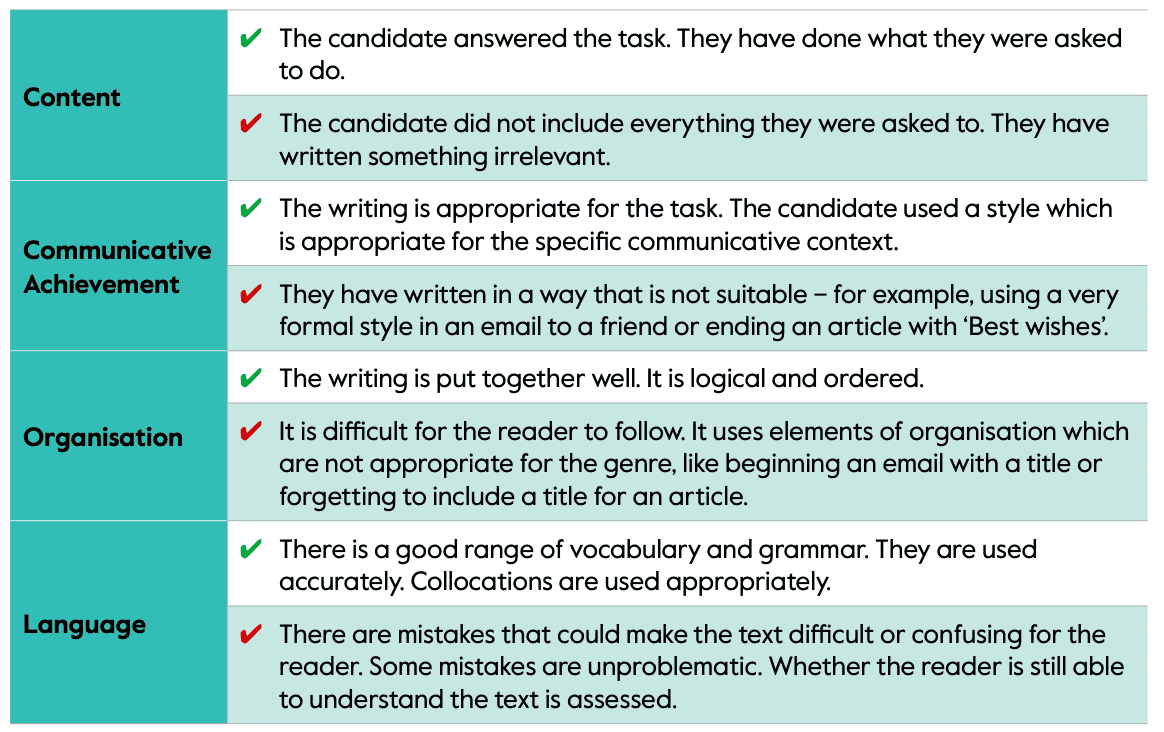
The detailed band descriptors for the four subscales are as follows:
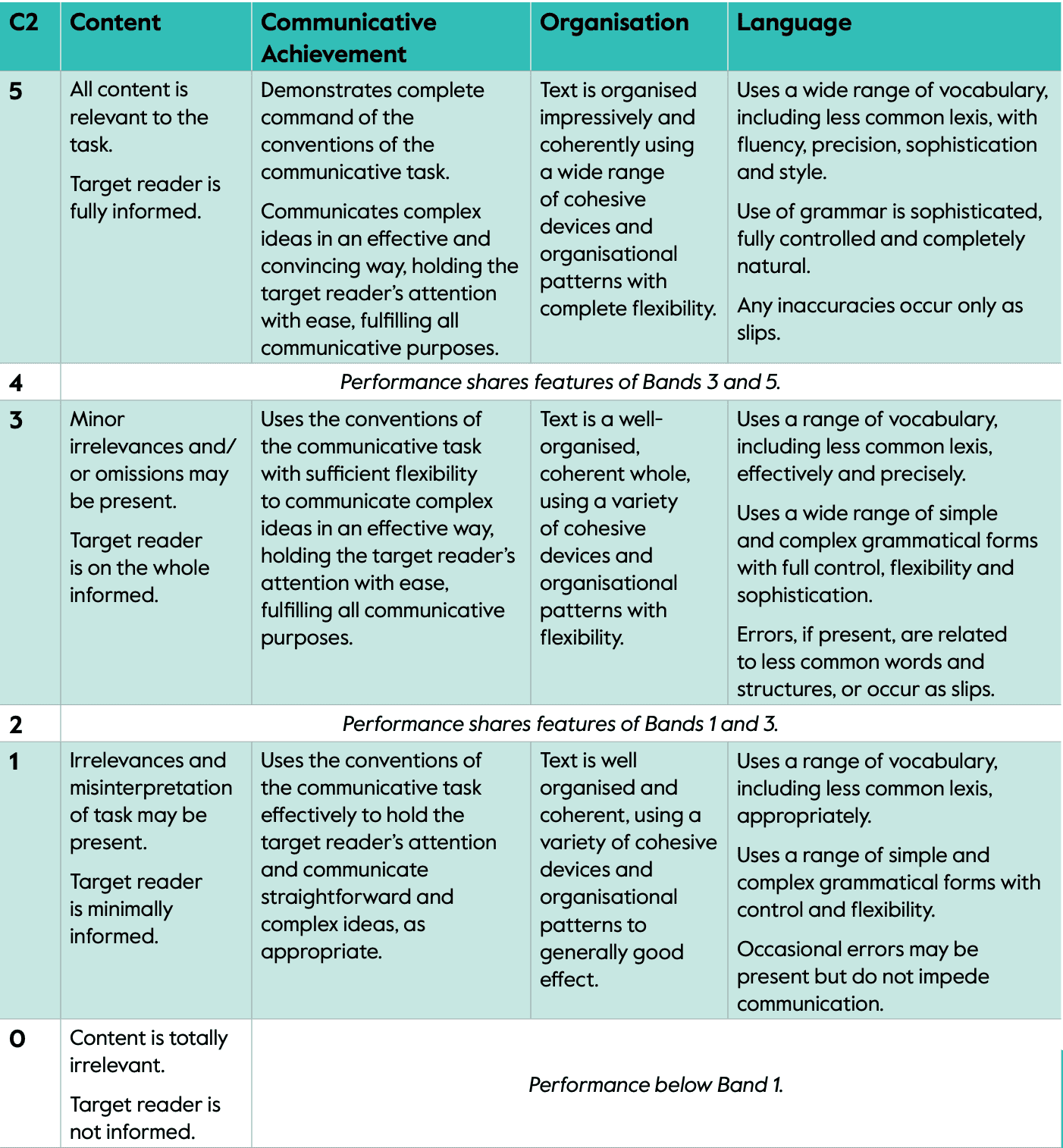
The descriptors above are essentially detailed notes to help examiners and teachers use the assessment subscales effectively to evaluate and grade a learner’s writing. Descriptors for Bands 1, 3 and 5 specify what skills a candidate is expected to demonstrate at lower, average and higher levels of ability.
The detailed descriptors in the Writing Assessment subscales are marginally different for each exam and are based on its target CEFR level. Nevertheless, all Cambridge English Qualifications aim to test a learner’s ability to understand and use English effectively in real-life contexts. Consequently, the descriptors for different exams are broadly similar.
If a candidate scores Band 3 or above in the C2 Proficiency exam, this indicates an ability of CEFR C2 level. Bands 1 and 2 signal that the candidate demonstrates a C1 level of English.
Here are a few more words about each of the four subscales and their respective band descriptors:
Content
The content subscale focuses on how well the candidate has fulfilled the task.
According to a checklist compiled by Cambridge English to improve your writing at C2 Proficiency level, you should pay heed to the following three questions for content:
- Have I covered all the key information required by the task?
- Have I written only information which is relevant to the task?
- Have I developed the basic points in the task with my own ideas?
Communicative Achievement
The communicative achievement subscale focuses on how appropriate the writing is for the task and whether the candidate has used a suitable register. For the compulsory C2 Proficiency essay-writing task, the level of formality should range from neutral to formal. The most important thing is to be consistent with the register you decide to adopt.
According to the same aforementioned checklist, candidates should consider the following questions:
- Have I achieved the main purpose(s) of the text (for example, explaining, persuading, suggesting, apologising, comparing, etc.)?
- Have I used a suitable mix of fact and opinion?
- Have I used a suitable style and register (formal or informal) for the task?
Organisation
Your composition needs to be logically ordered with sufficient attention given to coherence - that is the smooth and logical connection between ideas, words, sentences and paragraphs. In essence, there must be a sense of unity among your ideas.
Cohesion also comes into play with the compulsory essay task. Cohesion revolves around the flow of sentences and paragraphs from one to the other. One of the most prominent ways to create cohesion is through the use of transitional words and phrases from a broad range of categories, including causation (as a result, consequently), contrast (on the contrary, nevertheless) and intensification (in fact, undoubtedly).
Here are some questions for you to consider when it comes to structuring your essay:
- Have I used paragraphs appropriately to organise my ideas?
- Have I used other organisational features appropriately for the genre of the text (for example, titles, headings, openings, closings, etc.)?
- Is the connection between my ideas clear and easy for the reader to follow? (For example, have I used appropriate linking words, pronouns, etc. to refer to different things within the text?)
- Are the ideas balanced appropriately, with suitable attention and space given to each one?
Language
Here are some questions for you to consider when it concerns the use of grammatical structures and lexis:
- Have I used a wide range of vocabulary, including less common lexis and lexical chunks?
- Have I avoided repeating the same words and phrases and paraphrased where appropriate?
- Have I used a range of simple and more complex grammatical structures?
- Have I correctly used any common phrases which are relevant to the specific task or topic?
- Is my use of grammar accurate?
- Is my spelling accurate? You can use British or American spelling, but it must be consistent.
C2 Proficiency Writing Essay Task with a top-performing answer and analysis
The following task appears in the C2 Proficiency Handbook for Teachers:
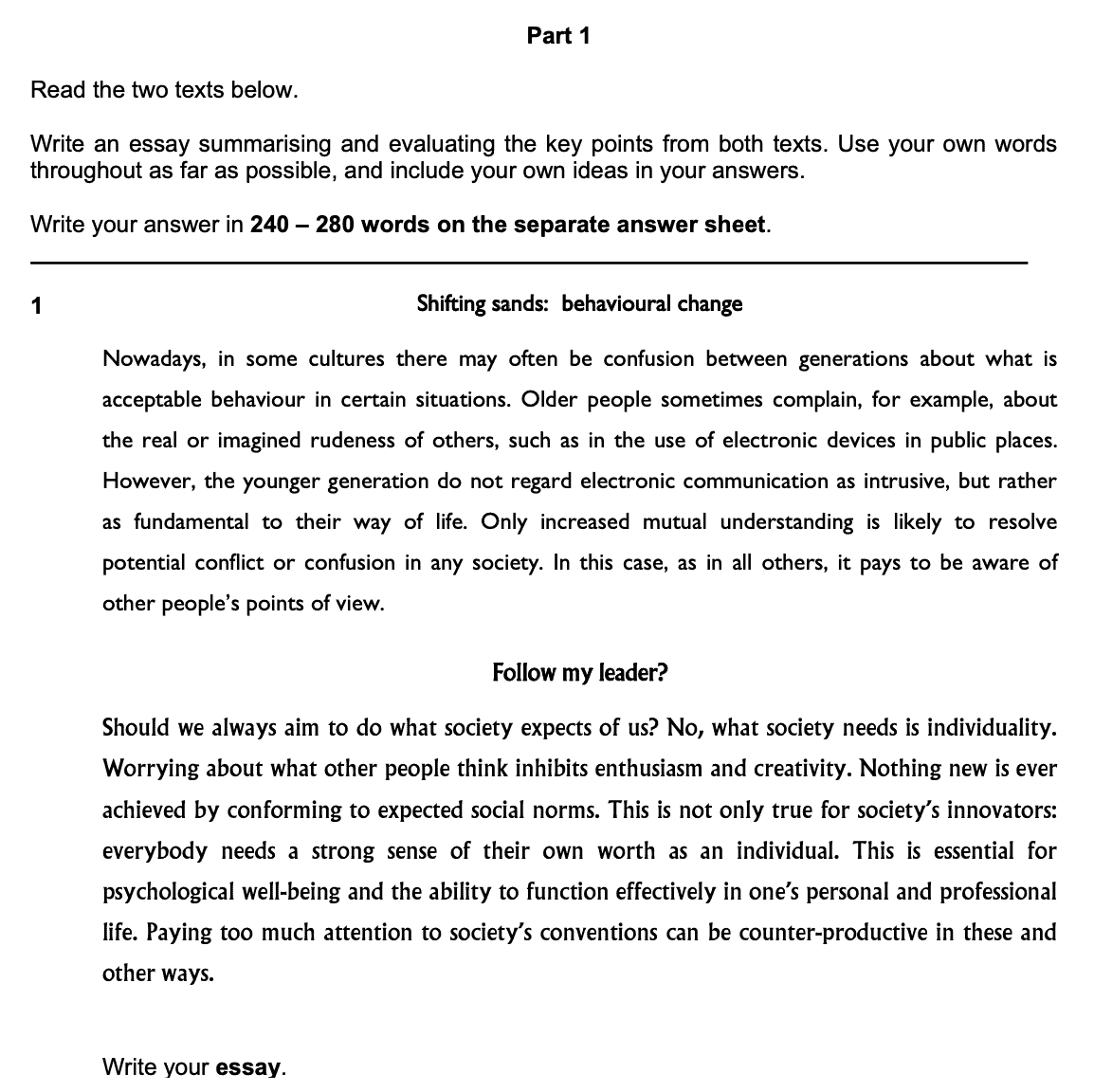
Both texts refer to social norms, intergenerational issues and the problem of individualism versus the collective.
Now that you have had a chance to read the two texts, allow me to present a top-performing answer, paying particular reference to the four subscales and their band descriptors outlined in the previous main section. This essay received top marks (a mark of 5 on each of the four subscales).
A top-performing answer
The following response gained full marks (20/20):
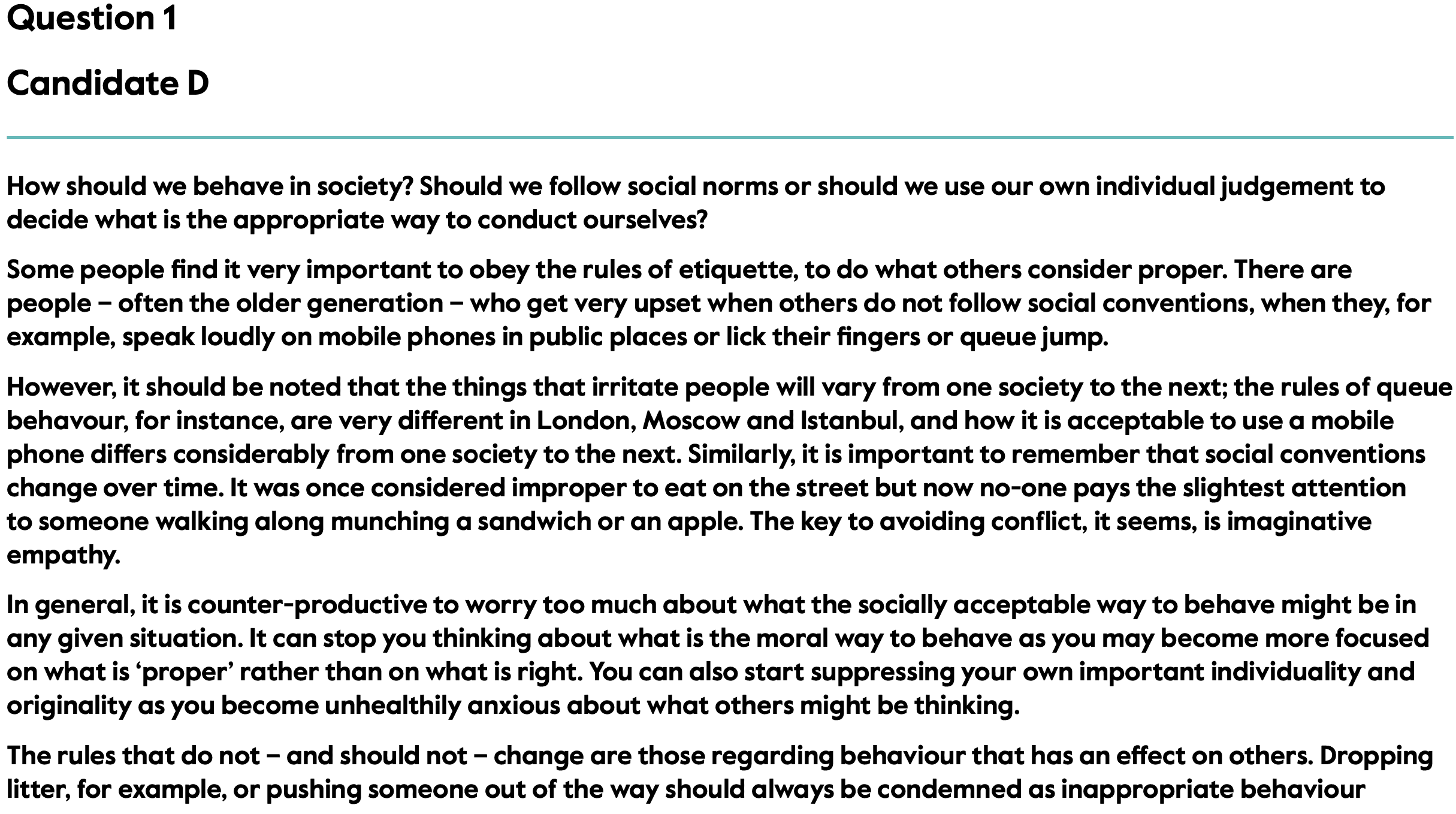
Here are the comments from Cambridge English:
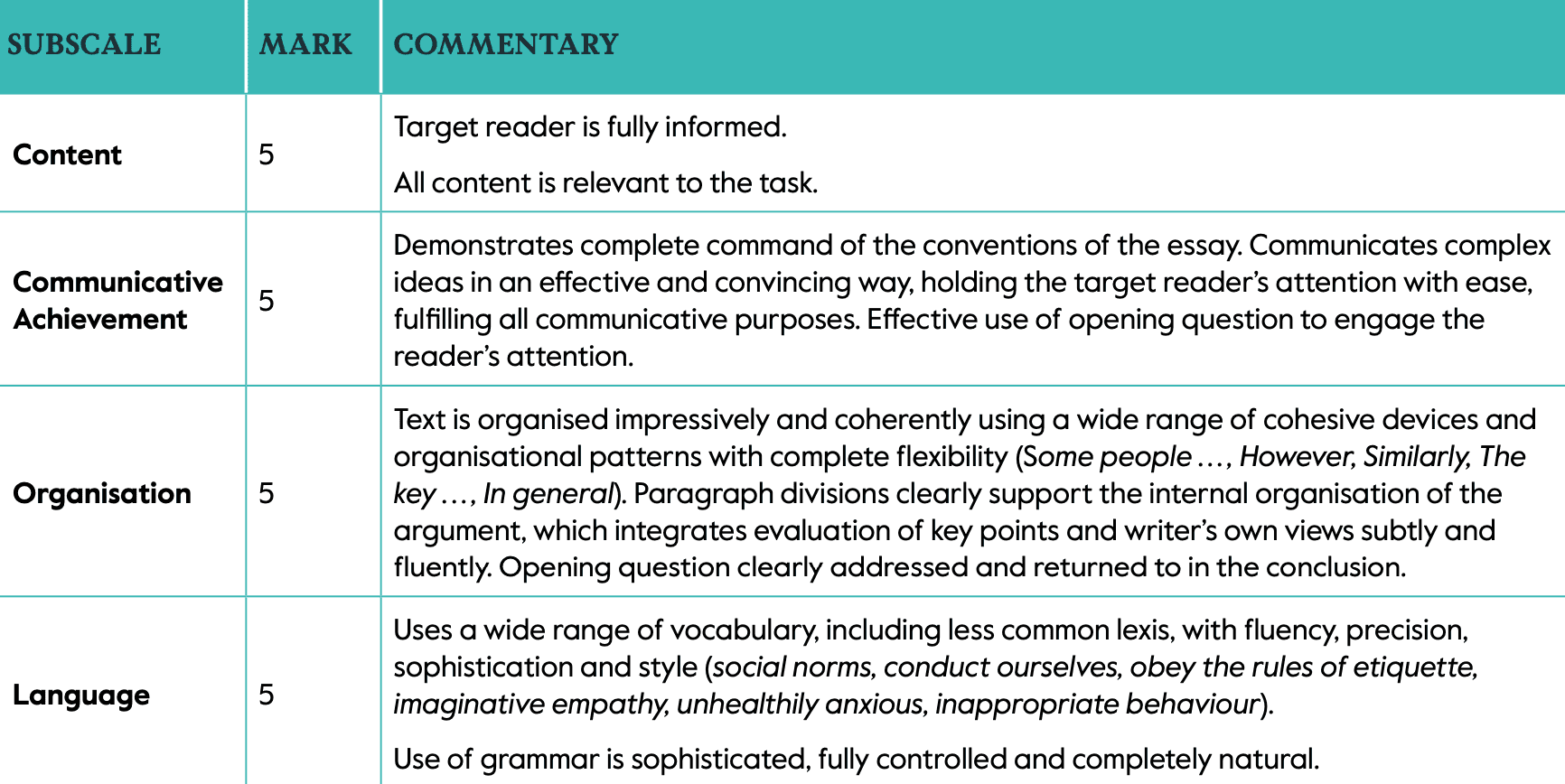
Content
All things considered, this top-scoring essay satisfies the top band (5) when it comes to the content subscale.
This subscale has little to do with one’s level of English. It is more about whether you’ve paid attention to the task, summarised and evaluated the key points from both texts, and included your own ideas where necessary.
Communicative achievement
As I mentioned in the previous section, the essay should have a neutral/formal tone. Frankly, the composition we’re considering is almost too informal in places. For example, language such as ‘pays the slightest attention to’ and ‘munching’ is rather colloquial. However, the most important thing with this answer is that the candidate is consistent when it comes to writing style. It is not overly formal and, on the whole, it is not excessively informal.
In the comments shared by Cambridge English, we can read that the candidate ‘Demonstrates complete command of the conventions of the essay’. Well, there is an introduction in the form of two rhetorical questions, praised by Cambridge English as an ‘effective’ means to ‘engage the reader’s attention’. Personally, it’s not the way I’d go about training students to write a discursive essay because a question really does need to be thought-provoking to capture the reader’s interest. While it may be true that the second question in candidate D’s response may encourage the reader to consider their own perspective about socially acceptable behaviour, I still think it’s a risky business to use rhetorical questions. One reason is because it’s difficult to phrase questions in formal, essay-appropriate language, thus having a detrimental effect on the subsequent overall tone of the essay. Secondly, you need to be cautious of using “yes/no” questions as they can sometimes appear too simplistic.
Organisation
The comments made by Cambridge English point to an impressively organised text whereby ideas are logically connected and flow smoothly from one to the next (i.e. coherence). A wide range of cohesive devices have been used to add to the overall coherence of the essay.
You must remember that the correct use of punctuation also adds to the overall coherence of an essay. Candidate D missed a few commas, before or in the introduction, and also between street and but in the third paragraph.
In the first sentence of the conclusion, the writer does return to the opening rhetorical question in the introduction. However, the conclusion, despite being well written, does not take the regular form of a closing paragraph. In the final sentence, it seems as if the candidate is developing an argument with further examples of “inappropriate behaviour”. This sentence seems out of place and is not representative of a summary at all.
Language
One of the main strengths of this essay is its inclusion of less common lexis and some very advanced collocations. Such chunks of language include:
- follow social norms
- obey the rules of etiquette
- imaginative empathy
- unhealthily anxious
Most of the lexical chunks used by candidate D are relevant to the task.
In terms of grammar, we may say that the writer’s use of grammar is fully controlled and sophisticated. There are examples of both compound and complex sentences and other more simple structures.
Further analysis of a top-performing essay
The entire purpose of the C2 Proficiency essay task is to summarise and evaluate the key points from both texts. It is generally the norm that there are TWO key points in each text.
Text 1 - Shifting sands: behavioural change
In ‘Shifting sands’, the first sentence about there being ‘confusion between generations about what is acceptable behavior in certain situations’ is the first key point. Looking at Candidate D’s essay, the second paragraph essentially summaries this key point. Unfortunately, the writer failed to contrast the older generation with younger generations.
The second key point in ‘Shifting sands’ is found in the fourth sentence:
Only increased mutual understanding is likely to resolve potential conflict or confusion in any society.
The candidate address the second key point by way of a short sentence at the end of paragraph 3:
The key to avoiding conflict, it seems, is imaginative empathy.
Although I feel that Candidate D developed too many of their own ideas in paragraph 3, and indeed could very well have continued evaluating the first key point, this short summary of the second key point is still well paraphrased and makes excellent use of a hedging device (it seems) to soften the claim that The key to avoiding conflict … is imaginative empathy. Without the hedging device (it seems), the sentence would sound overly certain. Therefore, hedging devices, also known as ‘cautious language’, help writers to express claims in a more neutral tone. More to come on hedging later on.
Text 2 - Follow my leader
In ‘Follow my leader’, the second sentence contains the first key point:
… what society needs is individuality.
The first key point is addressed by Candidate D in the form of:
You can also start suppressing your own important individuality and originality as you become unhealthily anxious about what others might be thinking.
Here, Candidate D cleverly paraphrases the first key point and its strongest supporting sentence in ‘Follow my leader’. As a reminder, here is that supporting sentence in the text:
Worrying about what other people think inhibits enthusiasm and creativity.
The following sentences (3,4 and 5) of ‘Follow my leader?’ are basically a continuation of sentence 2 with reference to the importance of individuality in society. Therefore, the second key point is covered by sentence 6:
[individual self-worth] … is essential for psychological well-being and the ability to function effectively in one’s personal and professional life.
The second key point is addressed by Candidate D in the opening of paragraph 4:
In general, it is counter-productive to worry too much about what the socially acceptable way to behave might be in any given situation.
This is a very nicely expressed sentence, although the candidate could have paraphrased counter-productive with, for instance, futile or pointless. Instead of repeating 'in one’s personal and professional life', candidate D produced the effective paraphrase in any given situation. Other excellent instances of paraphrasing include socially acceptable way to behave for society’s conventions.
_____
Overall, one particularly admirable feature of Candidate D’s essay is that the writer doesn’t directly refer to “the author of Shifting sands” or “the author of Follow my leader?" This is a sophisticated tactic.
Plan, plan, plan - Making the most of your time during the writing exam
If you’ve never been a huge fan of making plans before writing an essay, now is the time to change your ways.
For the C2 Proficiency essay task, I advise my students to spend 10 to 15 minutes putting together a plan. It may feel like a waste of time when the pressure is on to write a 240 to 280-word essay. However, planning will save you time and hassle when it comes to writing the essay as you will have an outline and main ideas to hand.
Frankly, having a decent plan will go a long way to settling the Content and Organisation subscales when you begin to write your essay. Instead, you will be able to devote greater attention to the Communicative Achievement and Language subscales. This includes your execution of lexical chunks, complex structures and an appropriate and consistent register.
Devising a plan for your essay
A plan for our sample essay task could look something like this:
- Introduction: generation gap; individualism vs conformity; social norms
- Topic paragraph 1: cross-generational differences - limits of acceptability; imaginative empathy required; DIFFERENCES EXPECTED DUE TO TENDENCY OF OLDER GENERATIONS TO EXPRESS DISSATISFACTION
- Topic paragraph 2: Individualism over collectivism/conformity; self-worth (e.g. among innovators) = contentment and capacity to perform in any given situation; INDIVIDUALS ONLY SUCCEED IN A COMMUNITY
- Conclusion: social norms = important but difficult to keep up with due to ever-changing nature; tolerance and discourse needed among different groups
The different parts of a discursive essay for C2
As you can see from the plan above, successfully navigating the C2 Proficiency essay task revolves around breaking up your essay into parts. These parts are - an introduction, (two or three) topic paragraphs and a conclusion:
Introduction
In contrast to the B2 First or C1 Advanced essay tasks, you have very little context to work with for the C2 Proficiency compulsory essay task. Moreover, you are not presented with a question that you could answer. It’s down to you to decide what you would like to focus on based on the topics of the two texts.
For our example task, an introduction may look a little like this:
In today’s world, we tend to coexist according to specific norms which we are all willing to conform to despite the fact they are open to interpretation. For instance, what may be permissible for a teenager may well be offensive to their parents. Moreover, even though western culture espouses personal freedom, there is surely a fine line as to where one’s own liberty may undermine the interests of the collective.
In the introduction, it’s vital that you paraphrase and summarise the very essence of the two texts, thus providing sufficient material to develop your topic paragraphs. Be sure to link ideas with cohesive devices, such as for instance, while and although.
Topic paragraphs
Topic paragraphs communicate the main ideas of your essay. They should generally be longer than the introduction and conclusion. It’s important that you avoid adding anything new in the introduction and conclusion that you don’t cover in the topic paragraphs.
Every topic paragraph requires a topic sentence. As the name suggests, a topic sentence summarises the main point of each paragraph. This topic sentence provides you with a springboard to elaborate on the topic.
Here are two topic paragraphs I wrote for our sample essay based on the plan above:
It is difficult to disagree with the author of the first text concerning the notion that only worthwhile dialogue and imaginative empathy brings about increased understanding and conflict resolution among different generations. Nevertheless, we need to bear in mind that elderly generations are not able to readily adapt to changes in society. For instance, older generations often cannot get to grips with advances in personal technology and the ongoing evolution of language. Moreover, many elderly people are not afraid to express their dissatisfaction with the way of the world as well.
A further point related to the division of society is the rise of individualism. The second text fervently advocates the notion that society as a whole benefits tremendously from the inventiveness and aspiration of certain individuals. In addition, cultural expectations only impede progress. Still, such a view opposes the fact that innovative individuals shine within a collective unit which allows them to turn their ideas into reality. Therefore, the two opposing concepts are dependent on each other.
Conclusion
Essentially, the conclusion should restate the key ideas of the essay (need for dialogue, individualism within a collective and change occurs continually). Here is my conclusion:
In summary, humanity as a whole is in a constant state of flux owing to the innovative ideas of younger generations. Only as a result of dialogue and tolerance of others’ conduct and outlook on life can we continue to thrive and maximise individual freedom for the betterment of society.
Time management
When it comes to time management for the two C2 writing tasks, you essentially have two options:
- Devote more time to part 2 as you need to write more words
- Dedicate roughly the same amount of time to both parts
Frankly, I recommend option 2 because you only have to write up to 40 more words for part 2. When you think about it, 40 words is not many. Moreover, the same number of marks are available for both tasks. Therefore, you can freely spend around 45 minutes doing the essay compulsory task.
As I stated earlier, it is wise to spend around 10 to 15 minutes planning your essay. Another 20 minutes can be spent writing your composition. You can spend the final 10 minutes reviewing your essay and checking the accuracy of the lexical chunks and structures you have used.
Writing a top-scoring discursive essay for C2 - Skills work
You need to and work on improving a number of skills in the run up to your C2 Proficiency writing test. Let’s dive in to see how you can best prepare for the discursive essay test:
1. Paraphrasing
Paraphrasing involves rewriting a phrase or sentence with the same meaning but using different words. A paraphrase is about the same length as the original phrase or sentence etc. Paraphrasing is an essential skill in the world of academia where students have to express the written thoughts of published authors in their own words.
There are various ways in which you can paraphrase. I will now go through three methods which you may combine to achieve clear and accurate paraphrased sentences.
Paraphrasing Method 1: Use Synonyms
It is actually quite a difficult skill to replace vocabulary in original sources with synonyms which have the same meaning.
Even though English has a plethora of synonyms, such as ‘big’ or ‘large’, it is uncommon for these words to have exactly the same meaning. Therefore, relying on synonyms when you paraphrase might result in sentences that are unnatural. Moreover, as Sowton (2012, p.21) states:
You must be careful not to misrepresent somebody’s opinion by poor use of synonyms.
For example, look at this original sentence (from Follow my Leader?) and two paraphrased alternatives:
Original sentence:
1. Nothing new is ever achieved by conforming to expected social norms.
Two paraphrased alternatives:
2. Nothing fresh is at any time accomplished through obeying assumed societal standards.
3. No novelty is under any circumstances attained by way of keeping to anticipated social conventions.
Native speakers and those proficient in English should immediately recognise that both sentences sound unnatural. While it is true that words such as ‘new’ and ‘fresh’, and ‘expected’ and ‘anticipated’, are closely related, they are only good synonyms in certain contexts and cases. Sentence 2 is a slightly better paraphrase of sentence 1 because more of the words have a closer meaning to their respective synonyms in the original sentence. For example, ‘accomplished’ work better than ‘attained’ and ‘through’ sounds more natural than ‘by way of’. Nevertheless, sentence 2 is not perfect because of the words ‘fresh’ and ‘assumed’, even though ‘assumed’ sounds more natural than ‘anticipated’. As an adjective, ‘assumed’ carries the meaning of something that you suppose to be true.
Paraphrasing Method 2: Change the order of words
Changing the word order of a phrase or sentence tends to be safer than using synonyms as the words remain the same. Therefore, the meaning will not change at all. Nevertheless, it is not straightforward to determine which words to move and indeed which position in a sentence the words should be shifted to. Furthermore, when you move a word, there’s a strong possibility that you might have to change some other words, add some words or delete some other words in order to make certain that the new sentence is grammatically correct.
Here are two propositions regarding how to change the word order without making errors:
(a) If the original sentence has an adjective and noun, change the adjective into a relative clause.
1. Writing essays can be a challenging task.
2. Writing essays can be a task which is challenging.
Once you have changed the word order, you can explore the idea of using different vocabulary:
- Writing essays → Essay writing
- can be → may be
- challenging → difficult
(b) If the original sentence contains two or more classes, change the order of the clauses:

With the word order transformed, we can now explore the use of appropriate synonyms:

Paraphrasing Method 3: Use different grammar
Here are two suggestions for how to change the grammar in the original text without making errors:
a. Changing the word class
Altering the grammar in original source material can be done by changing the WORD CLASS, also known as part of speech. For example, you might change nouns to verbs, or adjectives to verbs. Here’s an example of how a noun (solution) has been changed to its related verb form (solve):
→ The company needs to find a solution for this problem
→ The company needs to solve this problem
b. Changing the ‘voice’ of a sentence
Both the active voice and passive voice describe the relationship between the subject and the verb in a sentence. The Active voice describes how the subject performs the action. In contrast, you may use the passive when you wish to place greater emphasis on the performance of the action itself. This means that the subject comes after the main verb.
Here’s an example of how the active voice is transformed into the passive voice:
→ They CALLED OFF the meeting at the last minute (active - past simple)
→ The meeting WAS CALLED OFF at the last minute (passive - past)
2. Summarising short texts
The word “summary” should speak for itself when it comes to its definition. However, Gillett et al. (2009, p.185) illuminate what a summary for academic writing should contain. I believe the authors’ advice has tremendous relevance for the C2 essay writing task:
A summary should contain your chosen main points from the original text in a condensed manner. It should be written in your own words …
In addition to the above definition, Swales and Feak (2012, p.189) add another key point about summary writing in that a summary “should represent the source material in an accurate fashion.” Therefore, the essay writer should adopt a neutral tone when it comes to writing a summary.
Now, let’s go to the Proficiency Expert coursebook (2013) to see a sample C2 Proficiency essay task. The texts are about the use of computer games in the classroom, while the annotated notes to the side of the model answer show where the key points of the two texts have been summarised:
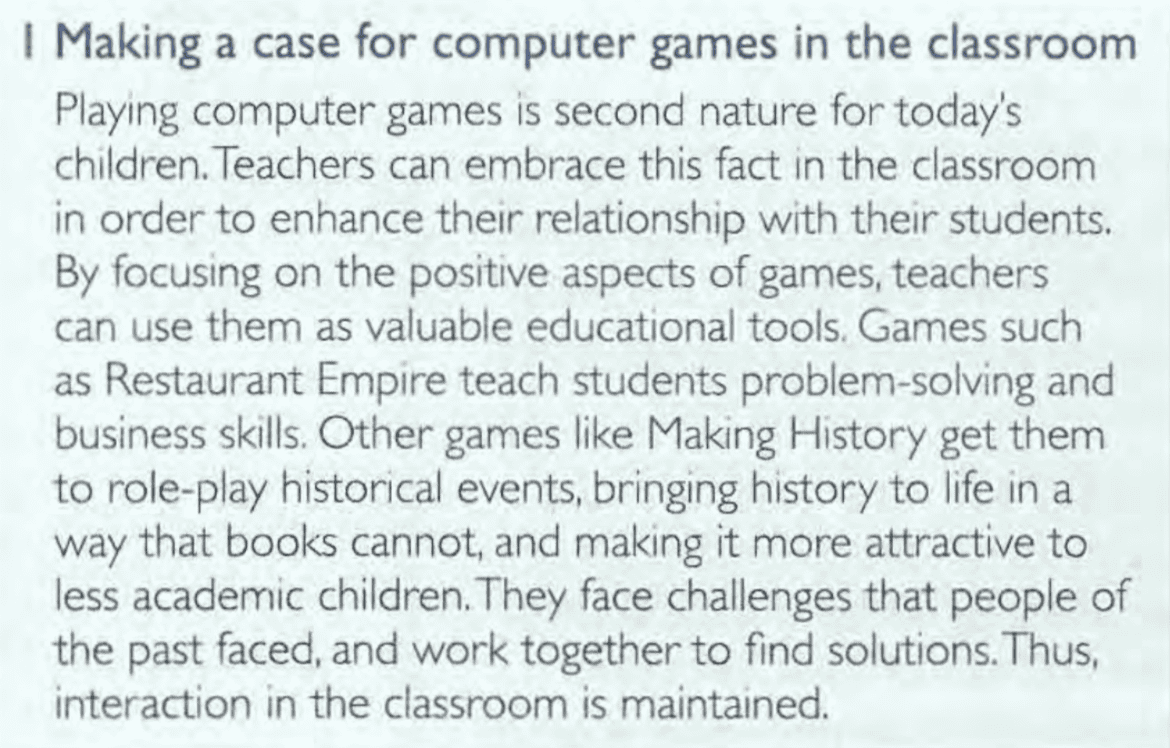
Source: Roderick, M. (et al.) (2013) Proficiency Expert Coursebook, Harlow: Pearson Education Limited, p.193
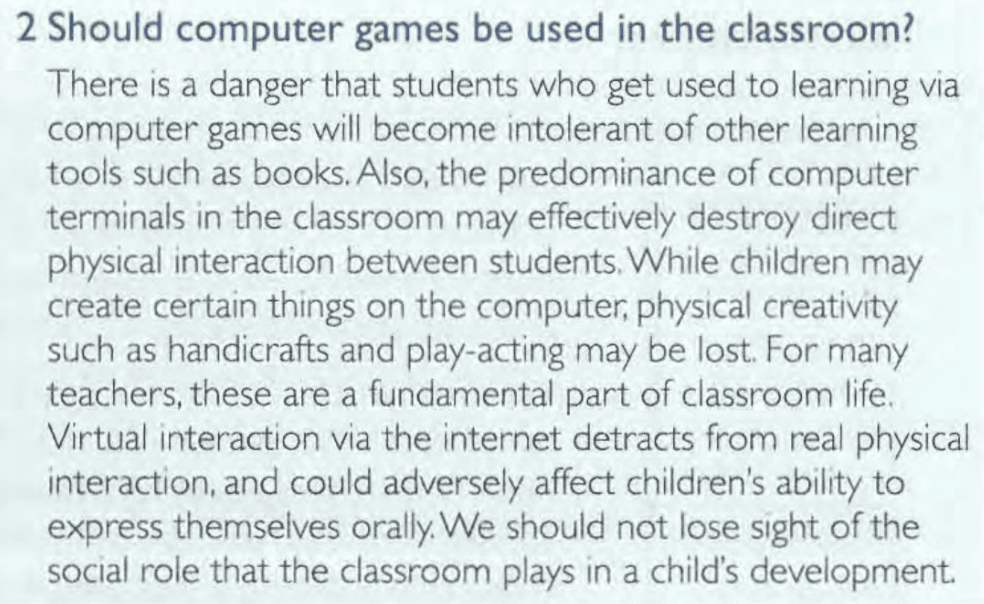
Source: Roderick, M. (et al.) (2013) Proficiency Expert Coursebook, Harlow: Pearson Education Limited, p.193
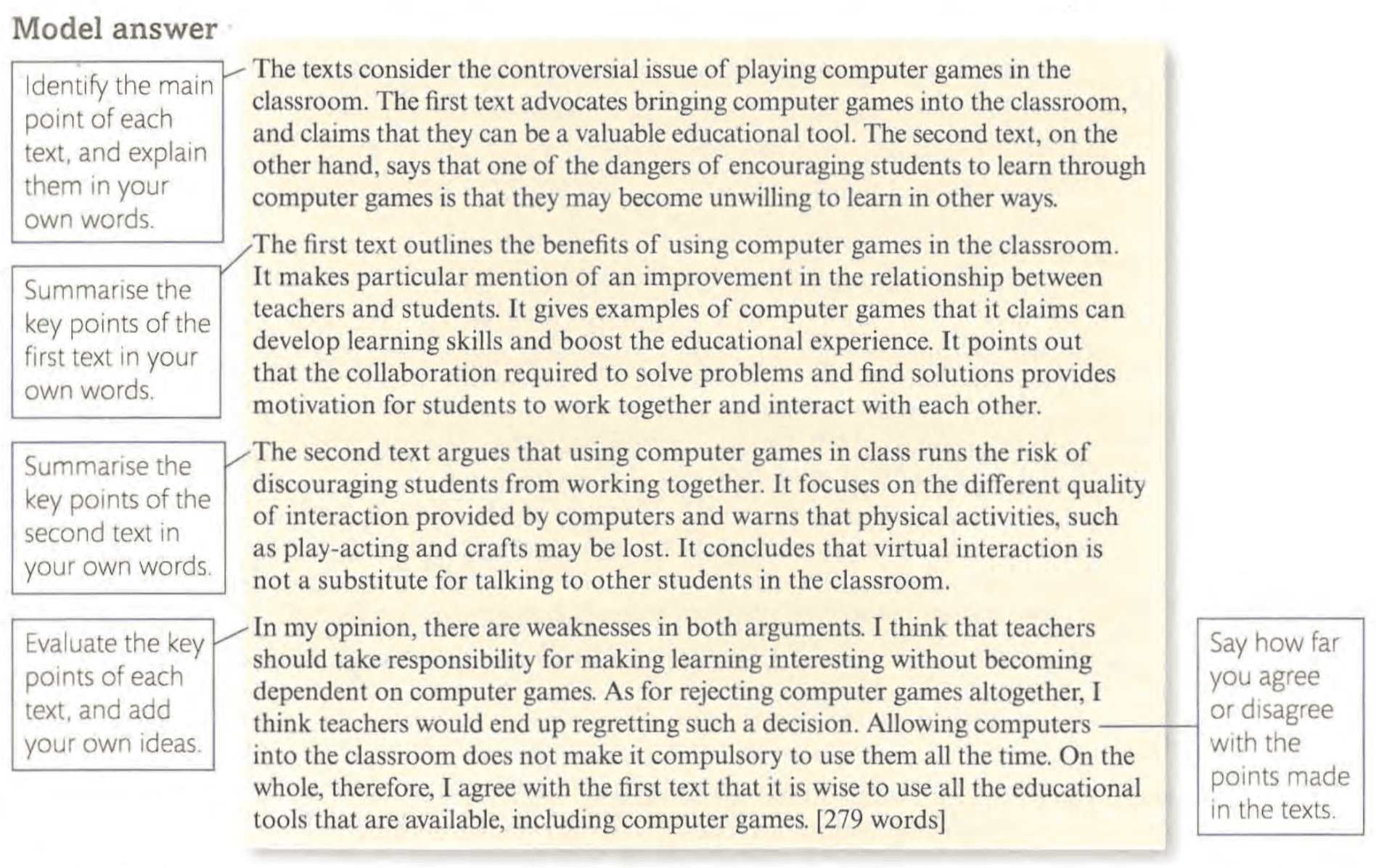
Source: Roderick, M. (et al.) (2013) Proficiency Expert Coursebook, Harlow: Pearson Education Limited, p.193
Check the original texts and topic paragraphs two and three of the model answer to see how well the candidate has summarised the key points of both texts.
Summarising exercises
Moving on, I will now share two texts with some accompanying exercises related to the strength of summary writing.
1. Culture Shock
Jordan (1999, p.94) shares a short text about ‘Culture Shock’ with a summary which asks the reader whether there is anything they would change:
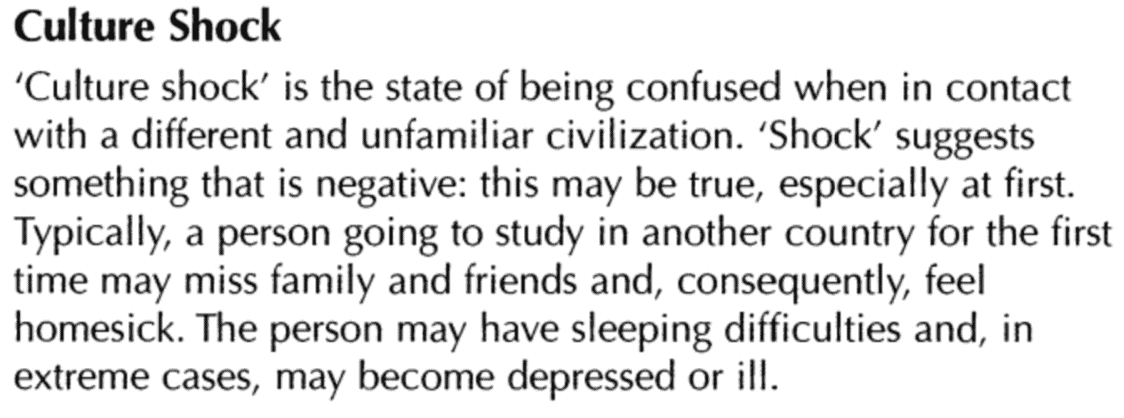

In my eyes, this is a more than reasonable summary. It focuses on the main points and omits examples and expansive supporting points. Moreover the summary contains instances of paraphrase. For example, there are word form changes, for example, confused to confusion, and vocabulary changes (unfamiliar civilisation to alien society).
2. Get happy with positive psychology
An exercise in Proficiency Expert (2013, p.46) draws our attention to effective summary writing. Here are the text and exercise in question:
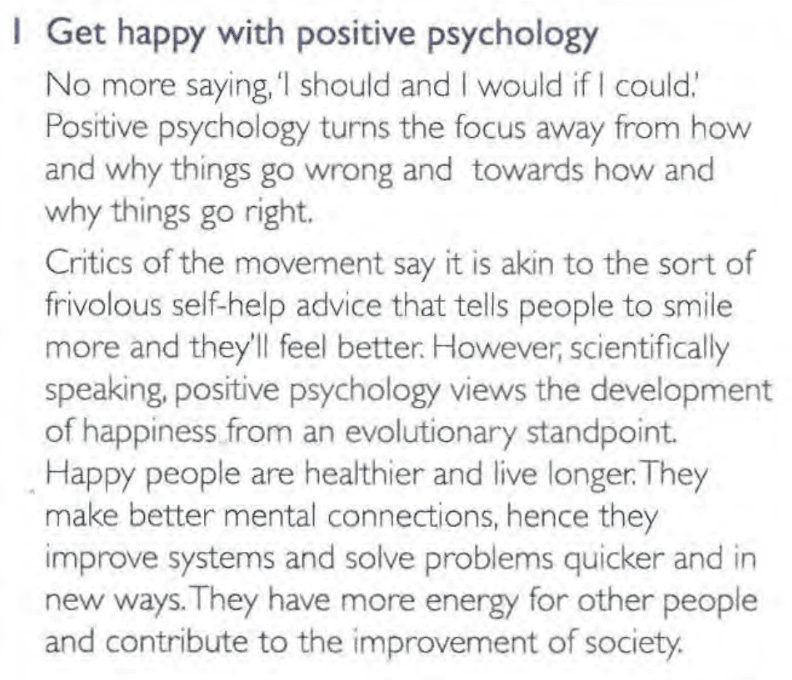

As you can see, the exercise asks students which the best summary of text 1 is. It turns out that summary 2 is the most suitable due to the fact it covers the key points of the text. Conversely, summary 1 omits key points, while summary 3 lifts phrases directly from the text.
3. Evaluating short texts
Let’s not forget that Cambridge asks candidates to write an essay “summarising and evaluating the key points from both texts.”
Evaluative language indicates the use of words and a wide range of expressions to express opinions, judgments, or assessments about a particular subject. Remembering that summary writing is objective in nature, evaluative language will help you to add a layer of subjectivity to your essay to communicate your perspectives.
Let’s return to the sample C2 Proficiency essay task with a Model Answer I shared in the second section of this post:


When it comes to evaluating key points, we can see how the model answer contains instances of evaluative language interwoven with the writer’s own ideas. Examples of expressions to evaluate the key points of the two texts include does not make a convincing argument and … makes a better case.
The following language may also help you to evaluate texts:
- Weighing up the points made in the two texts, it is clear that text 1 presents a more balanced view of the subject.
- Text 1 places emphasis on … but ignores the fact that …
- Admittedly … but nevertheless …
- To my mind …
4. Using cautious language to make nuanced claims
As I outlined earlier on in this post, you can draw on a range of hedging devices in order to express tentative, nuanced claims. Such cautious language can be used to respect the complexities within a topic, rather than present an overwhelmingly subjective viewpoint.
Hedging devices may take the form of the following four types:
- Modal verbs - might, may, can, could, should;
- Adverbs - probably, generally, relatively, evidently, possibly, typically;
- Adjectives - possible, unlikely, likely, probable;
- Verbs of moderation - appear, seem to (+ verb stem).
Tips to write grammatically complex and accurate essays
Now that we have covered some of the main skills you need to work, we can move on to the ways in which you can write more grammatically complex and accurate essays. Here are four ways:
1. Complex sentences
A complex sentence comprises both an independent and one or more subordinate clauses, also known as dependent clauses, which cannot stand alone. Complex sentences always contain either a relative pronoun (e.g. when, what, which, who, whose and that) or a subordinating conjunction (e.g. although, because, unless, while, until, as, since and provided that). The role of the subordinating conjunction is to introduce the subordinate clause.
It is common for subordinating conjunctions to indicate a cause-and-effect relationship or a connection between place and time:
- Cause and effect relationship: The meeting was cancelled as it was snowing heavily in the area
- Place relationship: There will always be pros and cons, wherever you choose to live
- Time relationship: I have always maintained a high level of fitness, which explains why I am quite slim.
Further examples of complex sentences:
- Although she works late into the evening, she always spends the whole weekend with her children
- After she graduated, she traveled around South America for six months
- She won’t pass the exam unless she does more revision
2. Compound sentences
Compound sentences contain two independent clauses which are joined by a coordinating conjunction (and, but, yet, so, or, for, nor). These independent clauses are essentially two self-sufficient sentences of equal rank which are combined into a single, unified sentence. A compound sentence requires a minimum of two subjects and two verbs.
There are similarities between complex and compound sentences. The difference lies in the type of conjunctions which connect clauses in both sentence types. To reiterate, subordinating conjunctions link a dependent clause to an independent clause in complex sentences. Conversely, coordinating conjunctions unify independent clauses about broadly similar topics in compound sentences. Take note of the fact that compound sentences tend to use a comma before a coordinating conjunction. If you don’t use a coordinating conjunction, insert a semicolon between the two independent clauses.
Examples of compound sentences:
- The island was dangerous, so the pirates moved in
- Earth is an ellipsoid, and it has a circumference of roughly 40,000 km
- He was an eccentric pianist; music was his passion
Notice in the third example how a semicolon has replaced a coordinating conjunction. The effect of this is to create a more precise and succinct sentence.
Compound sentences with conjunctive adverbs
It’s also possible to use conjunctive adverbs instead of coordinating conjunctions in order to eliminate some of the abruptness associated with the latter. Nevertheless, there are a couple of punctuation rules you need to bear in mind:
- The adverb must appear immediately after the semi-colon
- There must be a comma after the adverb.
Here are a few examples:
- The weather app said it would rain that morning; however, no clouds were in the sky when they woke up
- Their parents are hopelessly indecisive; consequently, it takes over an hour for them to pick a restaurant.
3. Stance adverbials
In essay writing, adverbs (or adverbial phrases) are often used at the beginning of sentences. Two of the main reasons they may appear here include:
(a) Authorial stance on a particular topic. This may include:
- Doubt (apparently, arguably, presumably, seemingly)
- Certainty (undoubtedly, unquestionably, without doubt)
- Reality (in truth, in fact)
- Expectation (inevitably, predictably)
- Reaction (unexpectedly, surprisingly, interestingly)
(b) Cohesion/linking to previous idea (on the contrary, similarly, likewise, in the same way)
4. Focus on learning lexical bundles and prepositional phrases
When it comes to writing grammatically accurate compositions for the C2 Proficiency essay task, you won’t go far wrong with strengthening your knowledge of the following two types of phrases:
(a) Lexical bundles
Lexical bundles, also known as extended collocations, are sequences of three or more words which often co-occur in a specific language register, such as academic writing. Such multi-word expressions help to shape meaning and coherence in a text.
Lexical bundles which contain more structural words, such as articles, conjunctions and prepositions, can be remembered as single pieces of language. For example, it’s easier to mentally process the bundle with respect to the as a whole rather than analyse the bundle word by word (i.e. with + respect + to + the). Consequently, lexical bundles minimise the chances of making mistakes in terms of using prepositions, articles and so on.
Sowton (2012, p.161) provides an excellent range of three-word, four-word and five-word lexical bundles:
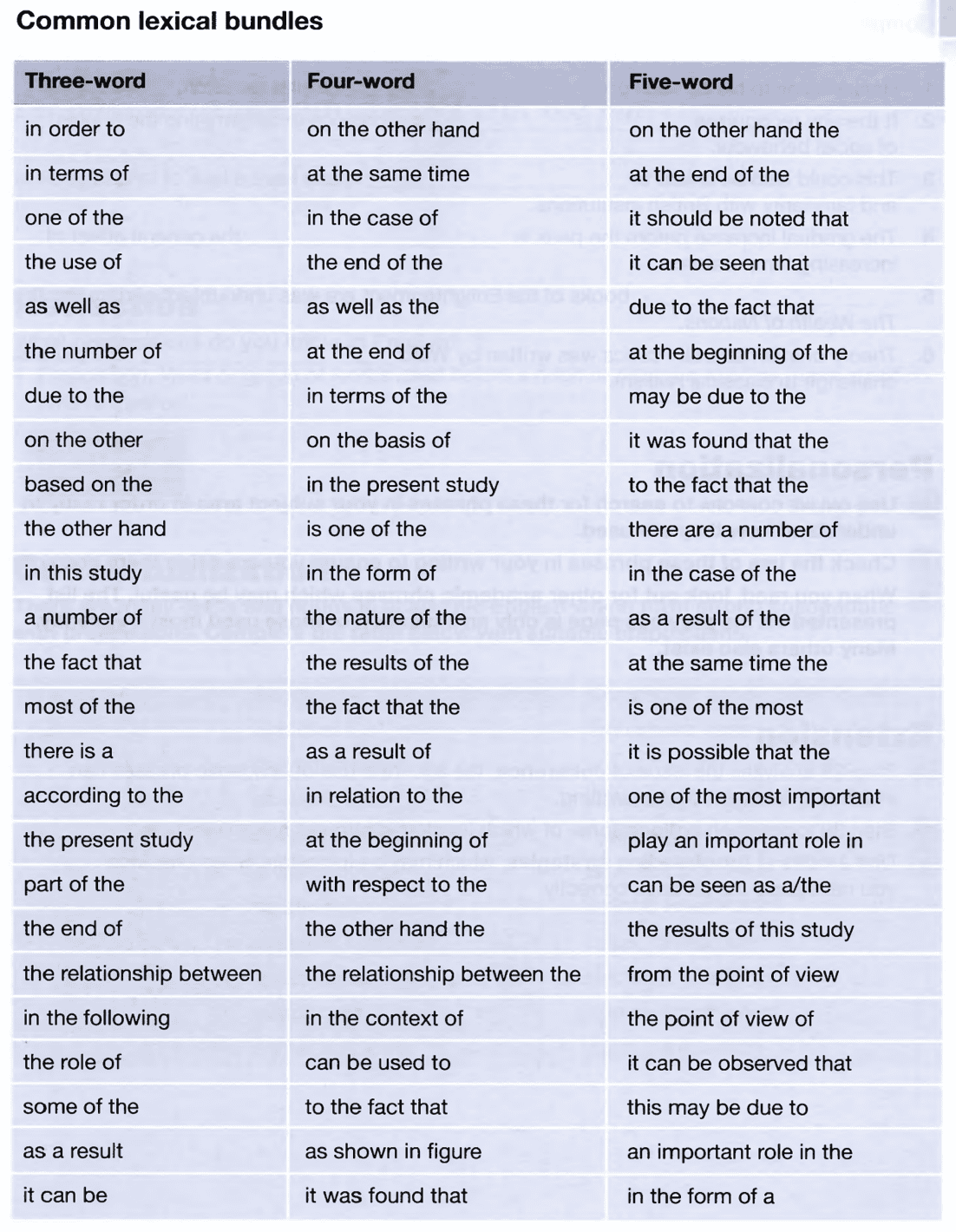
Source: Sowton (2012), p.161
(b) Prepositional phrases
Prepositional phrases consist of a preposition and a noun phrase. Being multi-word sequences, prepositional phrases also fit the definition of lexical bundles.
Prepositional phrases can add a richness to your writing and, as with lexical bundles, using them reduces the risk of writing an error-strewn essay.
Here’s Sowton (2012, p.165) again with a handy set of prepositional phrases:
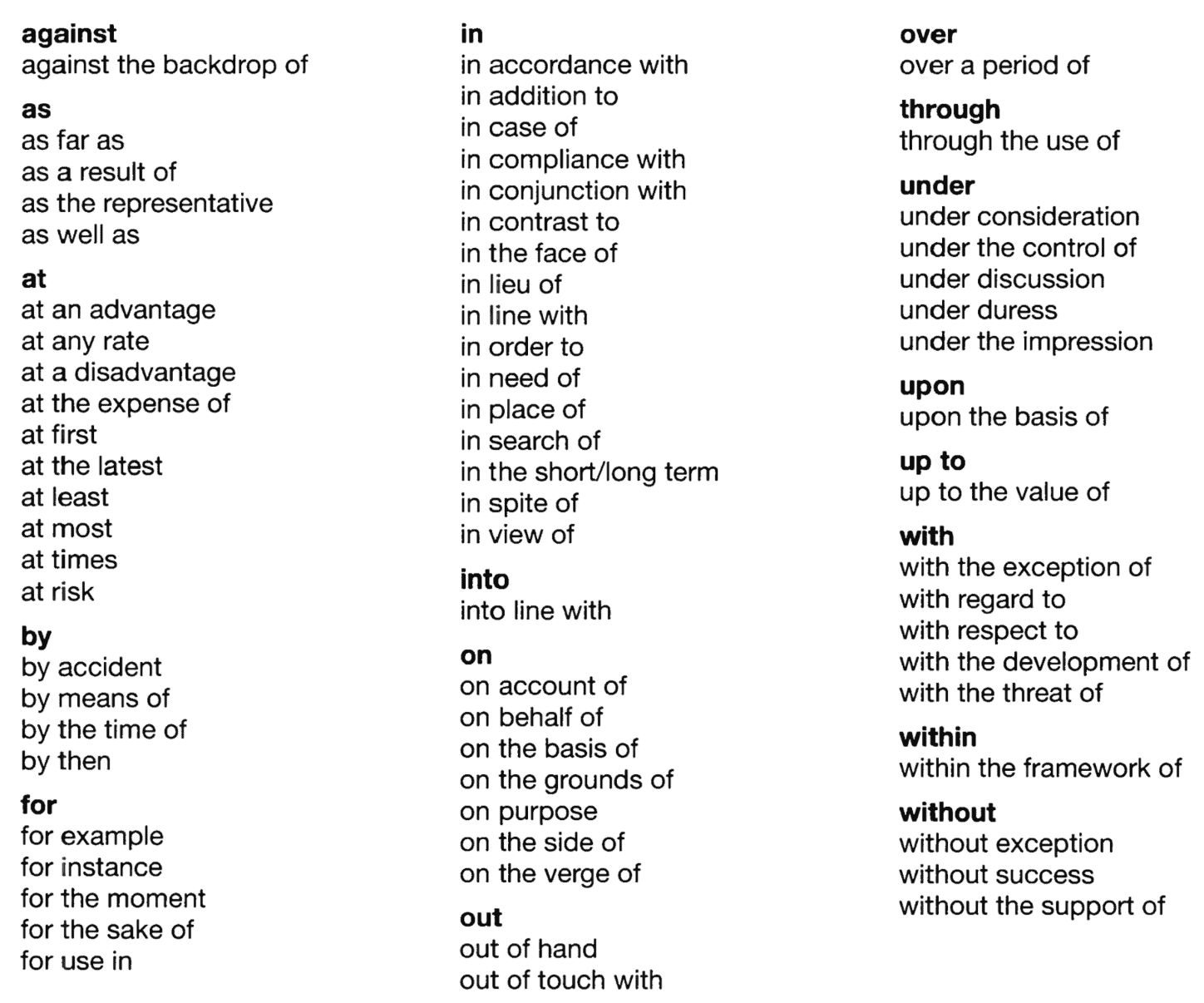
General Tips for Preparing for the C2 compulsory essay
This post is full of advice regarding how to write summaries, evaluate key points and write grammatically correct essays for part 1 of the C2 Writing test. I’d now like to share some more general tips on how to prepare for the essay task:
1. Read widely
It should go without saying that, in the run up to taking the C2 Proficiency exam, you should read widely. Reading extensively will help you to pick up more vocabulary, collocations, lexical bundles and increase your grammatical accuracy. Not only that, it will allow you to appreciate different styles of writing which you can then apply to your own writing.
2. Develop the habit of writing frequently
In this day and age, far too few of us write at all, particularly with a pen. You should develop the habit of writing frequently, even if it’s for 10 minutes every day, or every other day, in a personal journal.
3. Write 10-minute plans for questions in past papers
As I stated earlier, you should spend around 10 to 15 minutes planning what you want to write for the C2 essay writing task. In the run up to the exam, write 10-minute plans for a variety of questions in past papers. In this way, planning will become automatic, efficient and quick.
3. Familiarise yourself with model answers in the C2 Proficiency Handbook for Teachers and coursebooks
Before your C2 exam, you definitely want to familiarise yourself with model answers to part 1 essay tasks in the C2 Proficiency Handbook for Teachers and various coursebooks.
The sample answers related to the two texts about behaviour change in the C2 Proficiency Handbook for Teachers are deliberately varied in terms of their quality. Study the answers and the comments shared by Cambridge English for ideas on the kind of register and language you should use in your own composition on the day of the exam.
In coursebooks such as Cambridge English Proficiency Masterclass, the sample answers to part 1 essay tasks are often excellent models worthy of your attention. Usually accompanied by a set of comments on the model answer, you will find out how and where the writer:
- refers to both texts in the introduction
- signals a reference to the contrastive nature of the texts
- focuses attention on the ideas in text 1 or text 2
- paraphrases
- provides a clear shift to personal stance indicating evaluation
- uses various kinds of grammatical structures to suit a more formal register. Examples of such structures include the use of participle clauses (Having possession of more and more items …) to maintain a link with the previous sentence, and also inversion
- clearly marks the transition to the second text to give a balanced alignment
- uses concessionary clauses to express an idea which suggests the opposite of the main part of the sentence. These clauses often start with words or lexical bundles such as: Whilst, although, even though and in spite of
- indicates personal opinion
- re-states their main argument (i.e. in the conclusion).
4. Practice exam tasks
Of course, before your C2 exam you need to practise exam tasks with strict time limits and word limits in order to simulate the real exam.
Many C2 exam tutors, such as myself, will be more than happy to check and mark your writing compositions for free if you are already taking regular classes with your tutor.
5. Work on improving weak model answers
Coursebooks such as Cambridge English Proficiency Masterclass contain essays which contain rather weak model answers. You can read these essays and try to improve the areas you think need improving.
Final Thoughts
In my post on becoming an English proficiency teacher and C2 exam tutor, I wrote about the need to step out of my comfort zone after so many years being a conversation tutor and proponent of learning lexical chunks.
Teaching writing skills is actually nothing new for me. For four consecutive summers (2011-14) I taught academic writing skills to those from abroad wishing to embark on undergraduate and master’s degrees at The University of Southampton. However, preparing myself to teach students to ace the compulsory C2 essay writing task has been thoroughly eye-opening and rewarding. I’m ready to step outside of my comfort zone again. Teaching writing skills is just part of my broader mission to deliver a top-notch online C2 Proficiency course.
When it comes to the C2 Proficiency essay task, which is part 1 of the writing paper, if you study excellent model answers, familiarise yourself with complex and compound sentences, and read widely to notice and then keep a record of all those collocations and lexical bundles suitable for essays, you won’t go far wrong. Just remember the importance of spending 10 to 15 minutes to plan your answer.
Extras
Contact me for help with preparing for the C2 Essay Writing Task and all other parts of the C2 Proficiency exam
Materials, video walkthroughs and exercises for the compulsory C2 essay writing task
https://www.cambridgeenglish.org/Images/600977-teacher-guide-for-writing-c2-proficiency.pdf
https://www.cambridgeenglish.org/images/182344-how-to-teach-the-compulsory-essay-handout.pdf
https://www.youtube.com/watch?v=-4kI9ZW9_5c
https://www.youtube.com/watch?v=iXtBEzR9tSw&t=1536s
For C2 exam candidates who are Polish:
https://engxam.com/pl/handbook/esej-przykladowe-tematy-i-odpowiedzi-c2-proficient-cpe/
References:
Gillett, A. (et al.) (2009). Successful Academic Writing, Harlow: Pearson Longman
Gude, K. (et al.) (2012). Cambridge English Proficiency Masterclass: Student’s Book with Online Skills & Language Practice, Oxford: Oxford University Press
Jordan, R.R. (1999). Academic Writing Course: Study Skills in English, Third Edition, Harlow: Pearson Education Limited
Roderick, M. (et al.) (2013). Proficiency Expert Coursebook, Harlow: Pearson Education Limited
Sowton, C. (2012). 50 steps to improving your academic writing: Study book, Reading: Garnet Education



